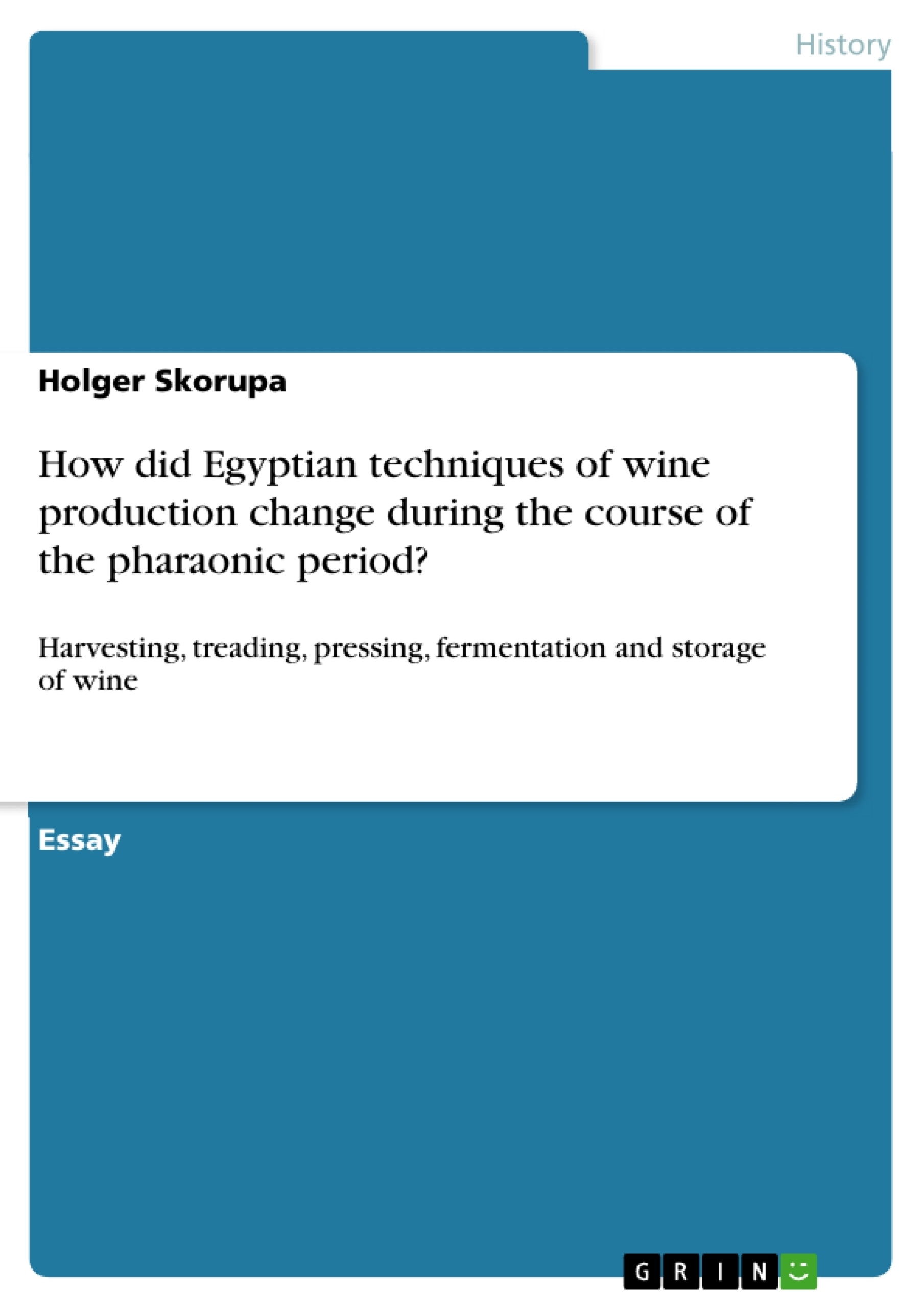How did Egyptian techniques of wine production (harvesting, treading, pressing, fermentation and storage) change during the course of the pharaonic period?
“Il est vrai néanmoins, que ce vin [the Egyptian wine] n‟est pas beaucoup estimé des Francs, à cause qu‟il reste toujours un tiers de lie, qui le rend trouble aussitôt qu‟on en veut verser. Mais si on avoit trouvé l‟invention de la bien faire purifier, ce suroit assurément un vien très délicieux (…).”
Although wine could not be indicated to be a typical element of the fauna of Egypt, skilled wine-makers of the Seventeenth Century proofed to produce a well-tasting juice, according to French traveller Vansleb. As archaeologists and historians - representing modern scholarship – have pointed out, that the wine-making process and its techniques have not been changed dramatically regarding the wine production utilized in Nineteenth and Twentieth Century, it is widely interesting to get to know more about Egyptian wine-manufacturing. Which tools were used to fulfil the difficult wine-making? How did a typical vineyard look like? Were there various types of wine and was it possible to get its taste throughout the whole society of ancient Egypt? Which role was played either by the reigning king or rather the gods – especially the goddess of harvest Renenutet?
By investigating and trying to answer these questions, it is certainly necessary to indicate possible sources stressing illustrations as well as textual evidence and archaeological basis. Obviously a huge amount of sources are available regarding the Middle and the New Kingdom, while, concerning the Early Dynasty and the Old Kingdom, useful information are rare. However several scenes taken from tombs dated from both periods give little evidence of techniques being utilized to success the wine-manufacturing. These artistic, textual, and archaeological evidence are highly important to observe, if ancient Egyptian wine could actually be described as “(...) excellent, white, pleasant, fragrant, easily assimilated, thin, not likely to go to the head (...)”, as it was signified by Greek Stoic and Philosopher Athenaeus in the Second Century A.D.
[...]
Table of Contents
- Early Dynasty
- Old Kingdom, Middle Kingdom, New Kingdom, and Late Period
Objectives and Key Themes
This text aims to provide a comprehensive understanding of the ancient Egyptian wine production process, examining its techniques and evolution throughout the pharaonic period.- Wine Production Techniques: The text explores the various techniques employed in wine-making, from harvesting to fermentation and storage, across different eras of ancient Egypt.
- Influence of External Factors: The study analyzes the potential influence of external sources on the development of Egyptian winemaking, considering possibilities like Western Asian influences.
- Social and Cultural Significance: The text explores the significance of wine in ancient Egyptian society, analyzing its use across different social classes and its role in religious and medical contexts.
- Archaeological Evidence: The analysis draws heavily on archaeological findings, tomb scenes, and textual evidence to reconstruct the wine-making process and its evolution.
- Evolution of Winemaking Practices: The text examines how wine production techniques changed and evolved over time, from the Early Dynasty to the Late Period.
Chapter Summaries
Early Dynasty
This chapter provides an overview of early wine production in ancient Egypt, focusing on the earliest evidence of wine-making from the beginning of the Early Dynasty, around 3000 B.C. The chapter explores the types of vessels used for wine storage and the methods of sealing and identifying them. It also touches upon the limited information available about wine production techniques during this period and the ongoing debate regarding the origin of Egyptian wine.Old Kingdom, Middle Kingdom, New Kingdom, and Late Period
This chapter delves into winemaking practices during the Old Kingdom, Middle Kingdom, New Kingdom, and Late Period. It highlights the significant increase in archaeological evidence and scholarly research on this topic, allowing for a more detailed analysis. The chapter covers the different stages of wine production, focusing on aspects such as the training and cultivation of vines, the harvesting and transportation of grapes, the pressing process, and the fermentation and storage of wine. It also investigates the use of specific tools and techniques, drawing upon tomb scenes and other visual representations.Keywords
This text focuses on the intricate history of wine production in ancient Egypt. Key terms and concepts include ancient Egyptian winemaking techniques, vineyard management, wine production, archaeological evidence, social and cultural context, evolution of winemaking, and external influences. The text also discusses the importance of understanding the specific terminology and representations of winemaking tools and processes depicted in tomb scenes and hieroglyphs.- Citar trabajo
- Holger Skorupa (Autor), 2008, How did Egyptian techniques of wine production change during the course of the pharaonic period?, Múnich, GRIN Verlag, https://www.grin.com/document/121081



